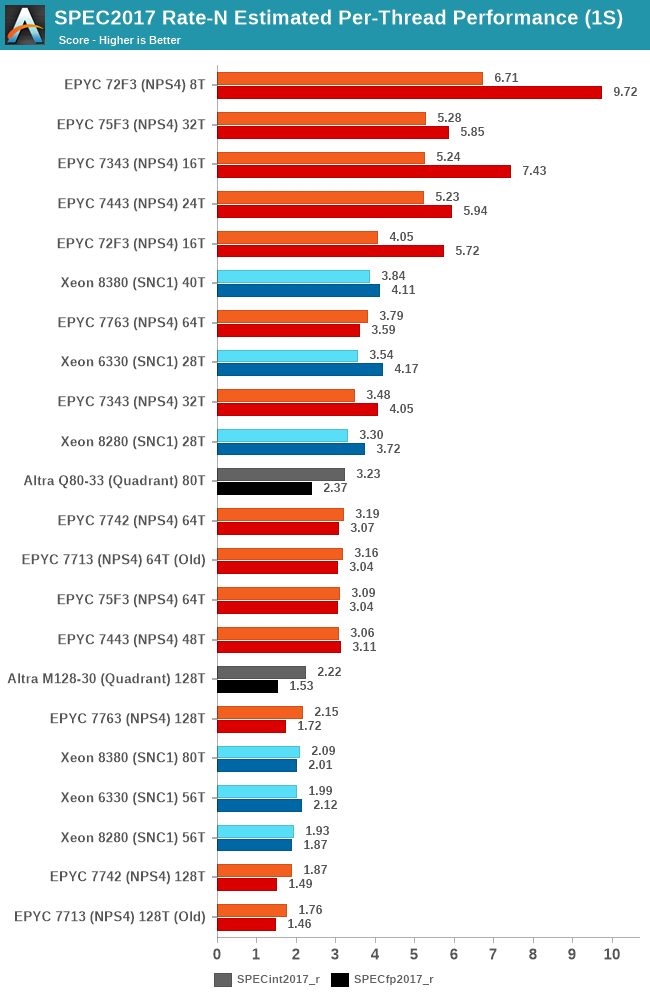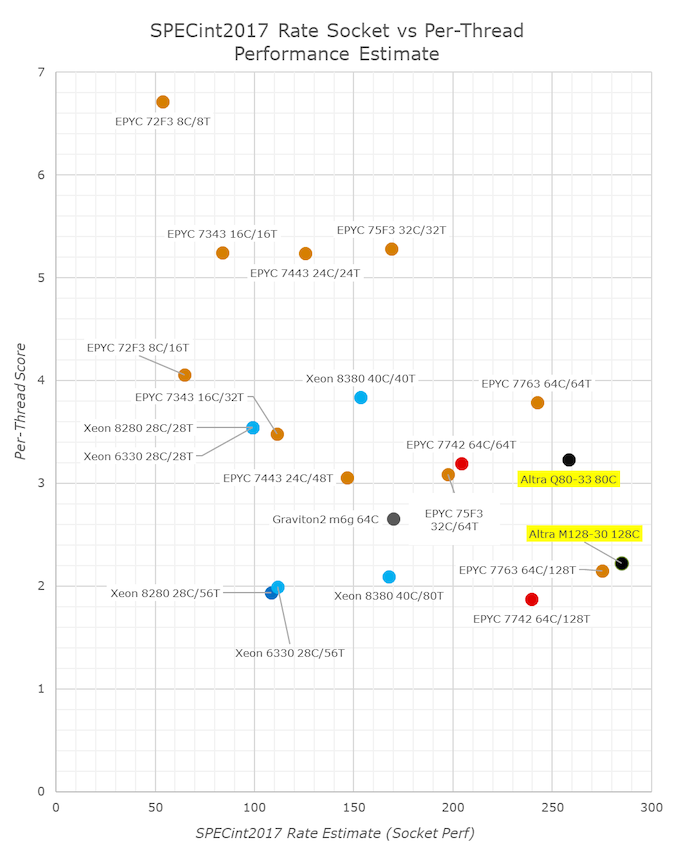The Ampere Altra Max Review: Pushing it to 128 Cores per Socket
by Andrei Frumusanu on October 7, 2021 8:00 AM EST- Posted in
- Servers
- Arm
- Neoverse N1
- Ampere
- Altra Max
SPEC - Per-Core Performance under Load
A metric that is actually more interesting than isolated single-thread performance, is actually per-thread performance in a fully loaded system. This actually is a measurement and benchmark figure that would greatly interest enterprises and customers which are running software or workloads that are possibly licensed on a per-core basis, or simply workloads that require a certain level of per-thread service level agreement in terms of performance.
The Altra Max here is inevitably expected to post worse metrics than the Altra – first of all due to the 10% lower core frequencies, and second of all due to lower shared resources that need to be shared amongst more cores.

As expected, taking view of the aggregate socket performance figures here, the M128-80 doesn’t fare well here in the metric, as it takes the much controversial “flock of chickens” approach to core performance. It’s also dragged down by the score regressions in the memory bound workload in SPEC.
In terms of total throughput vs per-thread performance, the M128-30 barely differs to the EPYC 7763 with SMT and half the physical cores.
Again, I have to reiterate that these figures are all very much not in favour of the workloads that the Altra Max was designed for – cloud and hyperscaler workloads, which don’t tend to have the same harsher memory demands as some of the workloads in the SPEC suite. However, extracting those workloads in a different subset would also be a questionable practise and actually frowned upon.
The Altra Max here really does need to have huge footnotes in the way that it presents itself.











60 Comments
View All Comments
lemurbutton - Thursday, October 7, 2021 - link
Before AMD can disrupt Intel in the server, Ampere has disrupted AMD. And now Intel is coming back with Saphire Rapids. Doesn't look good for AMD.Teckk - Thursday, October 7, 2021 - link
AMD also has upcoming products, same as other companies :) Competition is good.schujj07 - Thursday, October 7, 2021 - link
Most likely Sapphire Rapids will only get Intel to Epyc Milan or a little past there. Overall ICL Xeon only caught Intel up to Epyc Rome. Initial tests on Milan were good, showing 5-7% better performance which isn't bad, however, it wasn't like what we saw on the desktop side. Turns out the benchmarks were run on a reference platform that AMD hacked to allow 3rd Gen support. Once benchmarks were done on Milan on platforms designed for 3rd Gen the performance jumped by another 10% or more. Basically that put ICL 15-17% behind Epyc Milan and SPR is only supposed to get about 19% more performance.mode_13h - Thursday, October 7, 2021 - link
> Initial tests on Milan were good, showing 5-7% better performance which isn't badInitial tests were flawed, due to non-production hardware/firmware. Check out their update:
https://www.anandtech.com/show/16778/amd-epyc-mila...
schujj07 - Thursday, October 7, 2021 - link
"Initial tests were flawed, due to non-production hardware/firmware."I basically said that in my initial comment.
"Turns out the benchmarks were run on a reference platform that AMD hacked to allow 3rd Gen support. Once benchmarks were done on Milan on platforms designed for 3rd Gen the performance jumped by another 10% or more. "
GreenReaper - Saturday, October 9, 2021 - link
Your initial comment was too long, he didn't read that far before hitting reply.whatthe123 - Thursday, October 7, 2021 - link
icelake is not great in general. it was an improvement over 14nm but the core scaling was not there and their 10nm was still struggling to hit competitive boost clocks. I don't think the uplift they saw between 14nm and icelake reflects sapphire rapids at all considering the major design changes and improved node, but if it does I don't see how sapphire rapids would compete with milan at a lower core count. If its competing with milan then the per-core performance and MT scaling has seen a huge uplift compared to icelake.schujj07 - Thursday, October 7, 2021 - link
Had ICL come out on time people would have been more impressed. The problem that ICL has is since it was soooooo late Intel had to squeeze every ounce of performance out of SKL. Overall ICL is just a short term platform but the performance comparison to SPR.mode_13h - Friday, October 8, 2021 - link
> Had ICL come out on time people would have been more impressed.Depends on what you mean by "on time". If it had come in place of Cascade Lake, then probably. However, if it still followed Cascade Lake, then the clockspeed drop and strong competition from Rome & comparison with Graviton 2 are still unflattering.
If Ice Lake had notched up the clockspeed ladder *and* launched in place of Cascade Lake, then it would've been a very solid entry.
Anyway, I'm sure Intel is still selling every one they can make. People are quick to point out how AMD benefited from Intel's process woes, but the past 5 years' demand surge has provided Intel a very nice cushion. They basically couldn't have picked a better time to falter.
schujj07 - Friday, October 8, 2021 - link
I believe that ICL was supposed to be 2nd Gen Scalable. When Intel found that it wasn't ready, they released Cascade Lake. Even worse was needing to release Cooper Lake for 4-8S systems in 2H 2020.